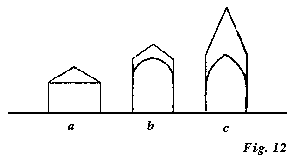VI. THE NATURE OF GOTHIC 253
certain helps from each other, into Arabian Gothic, and Teutonic Gothic. Its most perfect Lombardic type is the Duomo of Pisa; its most perfect Byzantine type (I believe), St. Mark’s at Venice. Its highest glory is, that it has no corruption. It perishes in giving birth to another architecture as noble as itself.
C. GOTHIC: Architecture of the Gable. The daughter of the Romanesque; and, like the Romanesque, divided into two great branches, Western and Eastern, or pure Gothic and Arabian Gothic; of which the latter is called Gothic, only because it has many Gothic forms, pointed arches, vaults, etc., but its spirit remains Byzantine, more especially in the form of the roof-mask, of which, with respect to these three great families, we have next to determine the typical form.
§ 90. For, observe, the distinctions we have hitherto been stating depend on the form of the stones first laid from pier to pier; that is to say, of the simplest condition of roofs proper. Adding the relations of the roof-mask to these lines, we shall have the perfect type of form for each school.
In the Greek, the Western Romanesque, and Western Gothic, the roof-mask is 
* The reader is not to suppose that Greek architecture had always, or often, flat ceilings, because I call its lintel the roof proper. He must remember I always use these terms of the first simple arrangements of materials that bridge a space; bringing in the real roof afterwards, if I can. In the case of Greek temples it would be vain to refer their structure to the real roof, for many were hypæthral, and without a roof at all. I am unfortunately more ignorant of Egyptian roofing than even of Arabian, so that I cannot
[Version 0.04: March 2008]